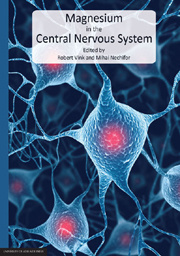Book contents
- Frontmatter
- List of Contributors
- Preface
- Contents
- Section 1 Magnesium in Normal Brain
- Chapter 1 Free magnesium concentration in human brain
- Chapter 2 Intracellular magnesium homeostasis
- Chapter 3 Magnesium transport across the blood-brain barriers
- Chapter 4 Intracellular free Mg2+ and MgATP2− in coordinate control of protein synthesis and cell proliferation
- Chapter 5 Magnesium and the Yin-Yang interplay in apoptosis
- Chapter 6 Brain magnesium homeostasis as a target for reducing cognitive ageing
- Section 2 Magnesium in Neurological Diseases
- Section 3 Involvement of Magnesium in Psychiatric Diseases
Chapter 1 - Free magnesium concentration in human brain
from Section 1 - Magnesium in Normal Brain
Published online by Cambridge University Press: 05 June 2012
- Frontmatter
- List of Contributors
- Preface
- Contents
- Section 1 Magnesium in Normal Brain
- Chapter 1 Free magnesium concentration in human brain
- Chapter 2 Intracellular magnesium homeostasis
- Chapter 3 Magnesium transport across the blood-brain barriers
- Chapter 4 Intracellular free Mg2+ and MgATP2− in coordinate control of protein synthesis and cell proliferation
- Chapter 5 Magnesium and the Yin-Yang interplay in apoptosis
- Chapter 6 Brain magnesium homeostasis as a target for reducing cognitive ageing
- Section 2 Magnesium in Neurological Diseases
- Section 3 Involvement of Magnesium in Psychiatric Diseases
Summary
Abstract
The cytosolic free magnesium concentration can be assessed in vivo in human brain by phosphorus magnetic resonance spectroscopy. This technique has been employed in human brain providing new hints on the Mg2+ homeostasis and on its involvement on the cellular bioenergetics. The free cytosolic [Mg2+] measured in the human brain is about half of that assessed in the human skeletal muscle. This result is likely related to the lower ATP concentration of brain tissue. The possibility to assess the cytosolic [Mg2+] in human brain opened the chance to study the involvement of Mg2+ in different neurological pathologies, and particularly in those where the defective mitochondrial energy production represents the primary causative factor in pathogenesis. The results obtained, studying patients affected by different types of mitochondrial cytopathies, helped to clarify the functional relationship between the energy metabolism and free [Mg2+], providing evidences that the cytosolic [Mg2+] is a function of the energy charge of brain cells and a defective mitochondrial respiration causes a derangement of cytosolic [Mg2+] homeostasis. A reduced cytosolic [Mg2+] has been also found in the occipital lobes of patients with different types of migraine and cluster headache, showing among migraine patients, a trend in keeping with the severity of clinical phenotype. In addition, the assessment by phosphorus magnetic resonance spectroscopy of brain [Mg2+] can help in the differential diagnosis of Multiple System Atrophy and Parkinson's disease, offering a new diagnostic tool that may help to differentiate neurodegenerative diseases sharing common clinical features.
- Type
- Chapter
- Information
- Magnesium in the Central Nervous System , pp. 3 - 12Publisher: The University of Adelaide PressPrint publication year: 2011



